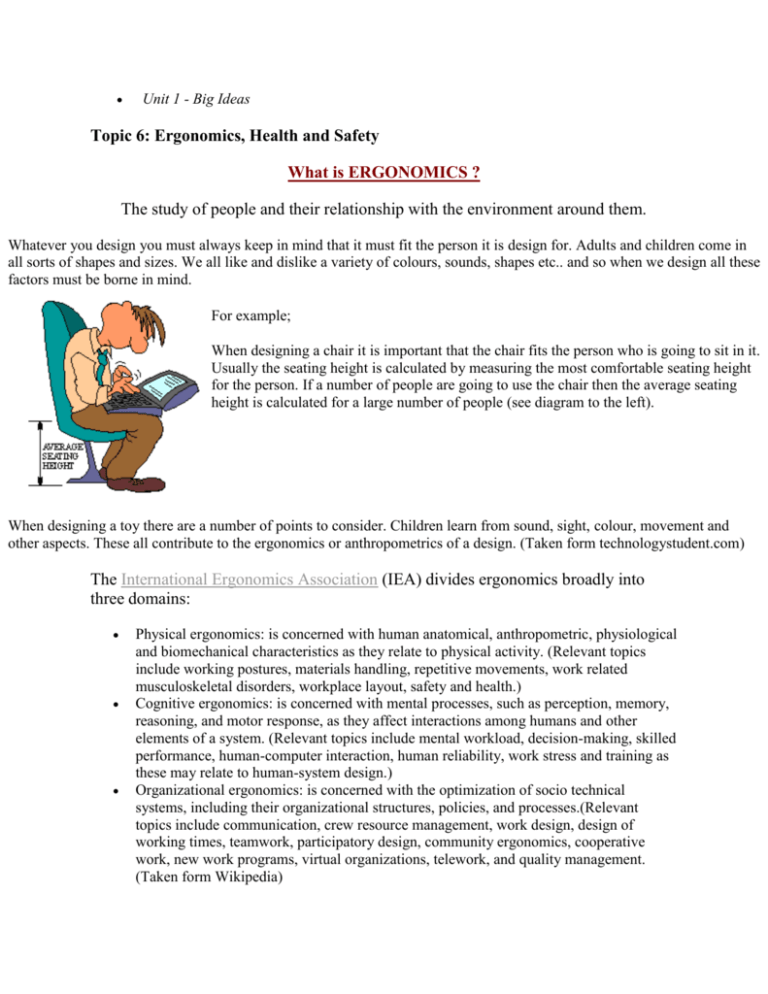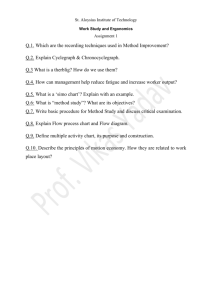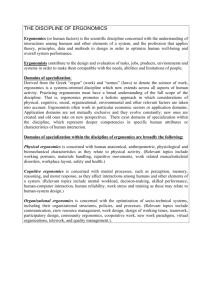File
advertisement

Unit 1 - Big Ideas Topic 6: Ergonomics, Health and Safety What is ERGONOMICS ? The study of people and their relationship with the environment around them. Whatever you design you must always keep in mind that it must fit the person it is design for. Adults and children come in all sorts of shapes and sizes. We all like and dislike a variety of colours, sounds, shapes etc.. and so when we design all these factors must be borne in mind. For example; When designing a chair it is important that the chair fits the person who is going to sit in it. Usually the seating height is calculated by measuring the most comfortable seating height for the person. If a number of people are going to use the chair then the average seating height is calculated for a large number of people (see diagram to the left). When designing a toy there are a number of points to consider. Children learn from sound, sight, colour, movement and other aspects. These all contribute to the ergonomics or anthropometrics of a design. (Taken form technologystudent.com) The International Ergonomics Association (IEA) divides ergonomics broadly into three domains: Physical ergonomics: is concerned with human anatomical, anthropometric, physiological and biomechanical characteristics as they relate to physical activity. (Relevant topics include working postures, materials handling, repetitive movements, work related musculoskeletal disorders, workplace layout, safety and health.) Cognitive ergonomics: is concerned with mental processes, such as perception, memory, reasoning, and motor response, as they affect interactions among humans and other elements of a system. (Relevant topics include mental workload, decision-making, skilled performance, human-computer interaction, human reliability, work stress and training as these may relate to human-system design.) Organizational ergonomics: is concerned with the optimization of socio technical systems, including their organizational structures, policies, and processes.(Relevant topics include communication, crew resource management, work design, design of working times, teamwork, participatory design, community ergonomics, cooperative work, new work programs, virtual organizations, telework, and quality management. (Taken form Wikipedia) Activity 1 Time: 1 class. Evaluation: Correct completion of activity. Imagine that you are designing an educational toy for pupils of your age. The educational toy is the type that will be picked up and handled. This means that it is important to collect measurements relating to the size of the hand. Look at the diagram of the hand below. Two dimensions (A and B) are shown on the hand . 1. Measure your hand and write the dimensions A and B at the top of the table below. Use millimetres. 2. Then collect the measurements of all other pupils in the class. 3. Work out the total of columns A and B and then work out the average of each column. Design yourself a chart similar to the one picture below and fill in the results: The average dimensions / measurements of A and B are important because an educational toy can be based on these. When manufactured, the educational toy can be said to be ergonomically designed. Pass in your completed list of measurements and answer the following questions. Which domain of ergonomics does this activity belong to? And What are the average hand measurements to consider when creating this toy?






